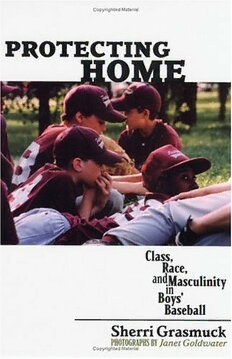
Protecting Home: Class, Race, And Masculinity In Boys' Baseball PDF
268 Pages·2005·1.396 MB·English
Most books are stored in the elastic cloud where traffic is expensive. For this reason, we have a limit on daily download.
Preview Protecting Home: Class, Race, And Masculinity In Boys' Baseball
Description:
"The best traditions of community and urban sociology come alive in this fantastic work of participant observation. Sherri Grasmuck shows us the people, narrates their lives, and links them to as sophisticated a take on race and class to be found in any contemporary urban ethnography. She is a beautiful writer with that rarest of gifts—a sober critical voice, an unrelenting systematicity, the wisdom of personal experience, and a sense of humor that comes together in a deep act of interpretation and explanation. Janet Goldwater’s fantastic photographs merge with the text to produce a documentary account of how we live today in multicultural America, one that takes its place among the finest firsthand studies."—Mitchell Duneier, Princeton University, author of Sidewalk and Slim’s Table"Based on skillful ethnographic research, and deploying a creative and evocative narrative voice, Protecting Home gives us fresh insights into the ways that youth baseball shapes race, gender, and class relations in a changing community. With this elegant piece of research, Grasmuck has connected and gone deep."—Michael A. Messner, author of Taking the Field: Women, Men, and Sports "An inspired and inspiring look at the rhythms of life in and around urban youth baseball. . . . Sherri Grasmuck shatters our stereotypes surrounding gender, class, and race."—Kathleen Gerson, author of No Man’s Land: Men’s Changing Commitments to Family and WorkThrough a close exploration of a boys’ baseball league in a gentrifying neighborhood of Philadelphia, sociologist Sherri Grasmuck reveals the accommodations and tensions that characterize multicultural encounters in contemporary American public life. Chapters explore coaching styles, parental involvement, institutional politics, parent-child relations, and children’s experiences. Grasmuck identifies differences in the ways that the mostly white, working-class "old-timers" and the racially diverse, professional newcomers relate to the neighborhood. Through an innovative combination of narrative approaches, this book succeeds both in capturing the immediacy of boys’ interaction at the playing field and in contributing to sophisticated theoretical debates in urban studies, the sociology of childhood, and masculinity studies.
See more
The list of books you might like
Most books are stored in the elastic cloud where traffic is expensive. For this reason, we have a limit on daily download.
